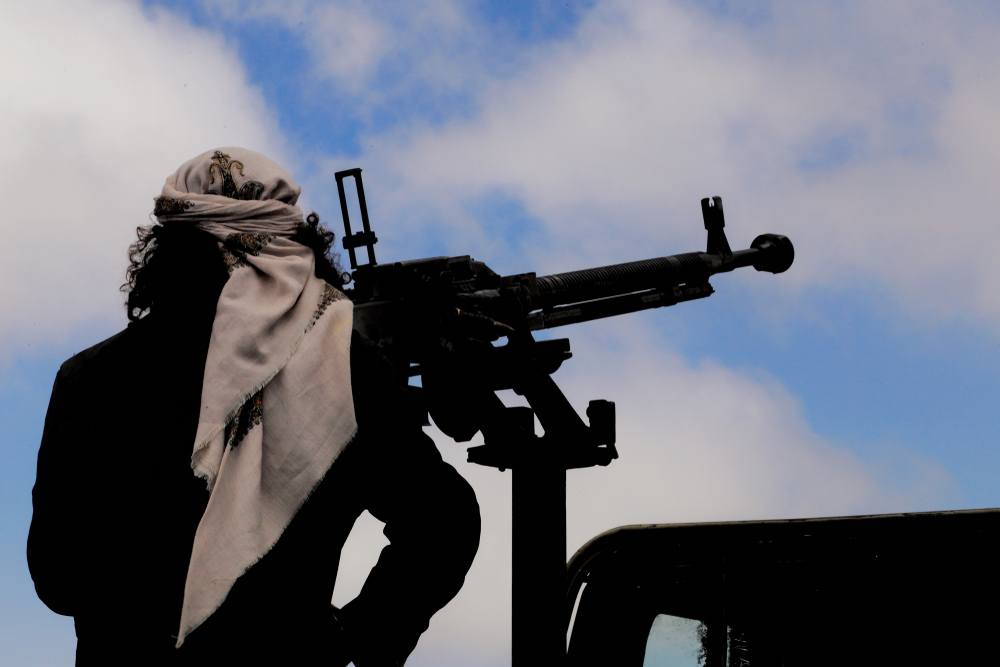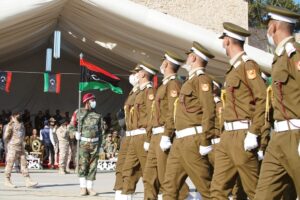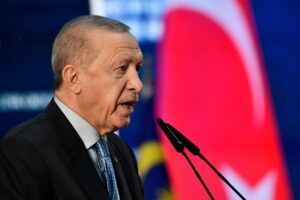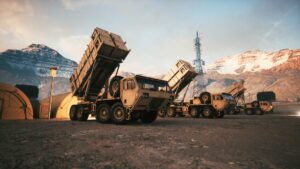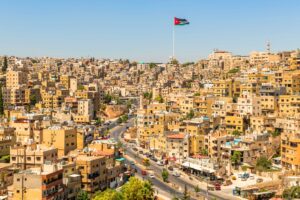In the short time since President Biden took office, arms sales to the Middle East have been increasingly under scrutiny and debate. U.S. support to Saudi Arabia and the United Arab Emirates, in particular, has dominated conversations about the consequences of U.S. arms sales to the region, due to their central role in the Saudi-led campaign in Yemen. Biden’s recent announcement that the United States was “ending all American support for offensive operations in the war in Yemen, including relevant arm sales” brought further attention to the devastating impact arms exports can have on civilians,[i] and renewed questions about the role and responsibility of the United States and other arms exporters in reducing risk and mitigating harm wrought by arms sales to the region.
This article considers the opportunities and challenges that exist to better regulate the flow of conventional weapons in the Middle East and Horn of Africa. More specifically, it examines the international mechanisms and regulatory architecture that exist to regulate the conventional arms trade, considers the extent to which these can be applied to regulate weapons flows in the region, and offers recommendations for increasing participation and supporting implementation of these instruments and other strategies to combat the unregulated trade in conventional arms, in a region already awash with weapons.
Home to just over 10 percent of the world’s 193 UN member states, the Middle East and Horn of Africa constituted 35 percent of global arms imports.
The Middle East and Horn of Africa are key players in the global arms trade. The region is home to just over 10 percent of the world’s 193 UN member states,[ii] but arms imports to the Middle East and Horn of Africa constituted 35 percent of global arms imports by volume between 2015 and 2019, according to the Stockholm International Peace Research Institute (SIPRI).[iii] During this same period, five of the world’s top ten arms-importing countries – Saudi Arabia, Egypt, the United Arab Emirates, Iraq, and Qatar – were in the Middle East.[iv] The United States is, and has long been, the region’s leading arms supplier. Between 2015 and 2019 the United States authorized $65.85 billion in arms sales to the Middle East and Horn of Africa[v] and supplied 53 percent of all arms transfers by volume to the Middle East in particular.[vi] Other leading exporters during this period were France and Russia, accounting for 12 and 11 percent of arms transfers by volume to the Middle East, respectively.[vii]
Current Mechanisms
Regulating the flow of conventional weapons in the Middle East and Horn of Africa should be a top priority for the global community. Poorly regulated arms transfers can exacerbate conflict, harm civilians, empower bad actors, and undermine regional and international security. These risks are all the more acute in the Middle East and Horn of Africa given the region’s already precarious security environment, active conflicts, proxy wars involving multi-state actors, and fragile states on the brink of conflict. Fortunately, there are several global conventional arms control mechanisms to do so. These include legally binding instruments like the Arms Trade Treaty and Firearms Protocol as well as voluntary frameworks like the UN Programme of Action on Illicit Small Arms and Light Weapons and the UN Register of Conventional Arms. These four instruments represent the only global regimes that address the trade in conventional weapons and that can be used to strengthen regulatory regimes in the region.
There are important differences between these four mechanisms[viii] but they all focus on increasing transparency and responsibility in the global arms trade as well as preventing and combating illicit arms transfers. These four mechanisms regulate legal arms transfers and hold potential for mitigating illicit weapons flows in the region, but they are only meaningful if they are implemented. Stronger controls on the legal trade help combat the illicit trade, as the majority of arms sales begin as legally transferred weapons. Each instrument has its own peculiarities and can be utilized to better strengthen national control systems and prevent diversion and misuse.
The Arms Trade Treaty (ATT) is the only legally binding instrument that regulates the conventional arms trade.[ix] The ATT focuses principally on better regulating the legal arms trade and requires States Parties to develop national systems that control the cross-border transfers of a wide variety of conventional weapons, from small arms and light weapons to conventional warships and combat aircraft. The ATT contains specific criteria and explicit prohibitions for arms transfer decisions and provides clearly delineated responsibilities for exporting, importing, and transit/transshipment activities. The treaty also encourages States to ensure their national control systems include measures to prevent and mitigate diversion. Moreover, a core tenet of the ATT is transparency. States Parties are required to annually report on their arms exports and imports to improve monitoring and shared awareness of legal arms flows around the world. States Parties must also report on the measures they take to implement the treaty by providing details about their national control systems and the ways in which they regulate the legal arms trade.
By comparison, the Firearms Protocol focuses on combatting illicit arms trafficking and directs States to “take appropriate measures” that help “detect, prevent and eliminate the theft, loss or diversion” of firearms, their parts and components and ammunition.[x] This legally binding treaty “provides for a framework for States to control and regulate licit arms and arms flows, prevent their diversion into the illegal circuit” and “facilitate the investigation and prosecution of related offences without hampering legitimate transfers.”[xi] Although the Firearms Protocol focuses solely on small arms and light weapons, the law enforcement and international cooperation mechanisms within the treaty are applicable and replicable for all conventional weapons. Moreover, SALW are the weapons most easily and frequently diverted, used to perpetrate harm and escalating conflicts, and thus combatting the illegal trade is beneficial to the region.
Of the region’s top five arms importers, none have ratified the Arms Trade Treaty – though one, the United Arab Emirates, has signed it – and just two, Iraq and Saudi Arabia, have ratified the Firearms Protocol.
However, regional participation in these treaties is lacking, undermining their utility as important tools to hold States accountable to responsible arms transfers. Just 14 percent of states in the Middle East and Horn of Africa are States Parties to the ATT[xii] and only 38 percent have ratified the Firearms Protocol.[xiii] Of the region’s top five arms importers from 2015 to 2019, none have ratified the ATT – though one, the United Arab Emirates, has signed it – and just two, Iraq and Saudi Arabia, have ratified the Firearms Protocol.[xiv] Participation is also lacking among the region’s top arms suppliers, namely the United States, France, and Russia. Of these major suppliers, only France has ratified the ATT and Firearms Protocol, while the United States and Russia have yet to ratify either treaty, though the United States has signed the ATT. The United States’ lack of ratification has more to do with domestic U.S. politics, rather than the ATT itself, and the U.S. has a national system that is in compliance with the obligations of both the Firearms Protocol and the ATT. Russia, on the other hand, has been skeptical of the ATT since the treaty was negotiated and has not indicated an interest in joining the growing number of States Parties.
Two key voluntary agreements also contain mechanisms that can prevent and mitigate illicit trafficking and diversion. Among them is the UN Programme of Action on Small Arms and Light Weapons (UN PoA), which contains guidance on numerous measures that States can take to strengthen their national systems to combat and prevent illicit arms trafficking in all its aspects.[xv] Among the measures included in the UN PoA are efforts to establish laws and regulations to control the production and transfer of small arms and light weapons, to integrate marking into the weapons production process, to take into consideration the risk of diversion specifically when assessing applications for export authorizations, to regulate brokers and brokering activities, to ensure States’ security forces develop and maintain standards and procedures for the management and security of their weapon stockpiles, and to promote weapons tracing to help better identify points of diversion – among many other relevant measures. The UN PoA encourages States to take steps at the national, regional, and global levels. If governments of the Middle East and Horn of Africa worked together to establish harmonized controls and approaches to the arms trade, it would go a long way to building confidence in the region.
A second voluntary arrangement is the UN Register of Conventional Arms (UNROCA).[xvi] UNROCA is a global transparency mechanism for States to report on their annual arms exports and imports – similar to the ATT, but open to all States to participate. The UNROCA serves as a useful tool for shining light on the traditionally opaque global arms trade, which is crucial to building confidence and trust amongst States and for identifying potentially destabilizing arms transfers. Transparency also allows others to assess the extent to which arms transfer decisions comply with existing international obligations and national laws and regulations.
Major Challenges
As with the legally binding treaties mentioned above, regional participation in these voluntary arrangements has been lackluster. A key method for States to engage with the UN PoA and UNROCA is through public reporting, yet consistent reporting from States in the region remains elusive. While many countries in the Middle East and Horn of Africa have reported at least once to these voluntary mechanisms, with 57 percent of States in the region having submitted at least one UNROCA report and 95 percent of States in the region having submitted at least one UN PoA report, the average year these States submitted their most recent report is perhaps more telling. On average, countries in the Middle East and Horn of Africa submitted their most recent PoA report in 2016 and their most recent UNROCA report in 2005. The lack of widespread reporting on arms transfers in the Middle East and Horn of Africa – as well as a clearer understanding of the laws, policies, and regulations guiding arms transfer decisions in the region – is troubling, particularly given the outsize role the region plays in the global arms trade. Without a fuller accounting of these transfers and States’ national control systems, we are left with an incomplete picture of the extent to which weapons flows to and from the region comply with international obligations and standards and whether States are adequately assessing risk and/or accumulating dangerous weapons supplies.
Ways Forward
The lack of implementation of and participation in these conventional arms agreements highlights three ways forward for the international community to address arms transfers in the region. First and foremost, States, including and especially major arms providers, should promote universalization and implementation of all four agreements. Recognizing that national political will is essential, efforts need to be made to work with States in the region to generate buy-in to these agreements. Regional governments need to understand why participation is a net win and can support legitimate trade while combatting illicit transfers and is a benefit to arms importers. Because there is no one-size-fits-all approach that moves State to action, a State-led approach to addressing conventional weapons priorities and needs must be undertaken. States know better than anyone which implementation measures will work best with their national transfer control systems and political circumstances.
Second, any attempt to develop additional control measures – for the region or the globally – must reinforce the standards of existing international treaties and regimes, and aim to support them, not compete with them or lower commonly agreed-upon standards.
Companies along the global supply chain and transfer process may unknowingly or unwittingly move legitimate commerce to illicit markets.
Finally, key stakeholders should be involved as partners in all aspects of the transfer process. Legitimate industry should be brought to the table to discuss ways in which they can contribute to stronger controls.[xvii] Companies along the global supply chain and transfer process may unknowingly or unwittingly move legitimate commerce to illicit markets. For instance, an engine manufactured by a German company and legally exported to Greece in 2015 was later diverted to Iran, in violation of German law, and used to construct a long-range armed drone used by Houthi forces in Yemen, according to UN and Conflict Armament Research investigators.[xviii] The illicit trade in arms is inextricably connected to the trafficking of other illicit goods. Those involved in arms shipments, such as brokers, transportation companies, or financiers are likely equally willing to participate in trading illegal narcotics or illegal fishing/animal if they see an economic benefit. It is crucial to harmonize laws and enforcement measures and create market incentives for companies to prevent illicit trafficking. Governments should work closely with industry to identify and utilize “choke points” to prevent illicit trafficking.
Controlling and regulating the global arms trade and combating and preventing illicit arms transfers requires a whole of government approach. National governments should ensure that these efforts are not siloed within a single agency, but instead are carried out across the various government agencies involved in the arms transfer process. Utilizing existing international agreements is an important first step, but importers and exporters must also put measures in place to ensure that their national systems are equipped and have the political backing behind them to ensure that arms are used in accordance with transfer agreements and do not perpetuate conflict or lead to human suffering.
[i] Rebecca Kheel, “Biden announces end to US support for offensive operations in Yemen,” The Hill, February 4, 2021, accessed March 2, 2021, https://thehill.com/policy/defense/537346-biden-to-announce-end-to-us-support-for-offensive-operations-in-yemen.
[ii] This article uses “Middle East and Horn of Africa” to refer to the following 21 countries: Bahrain, Cyprus, Djibouti, Egypt, Eritrea, Ethiopia, Iran, Iraq, Israel, Jordan, Kuwait, Lebanon, Oman, Palestine, Qatar, Saudi Arabia, Somalia, Syria, Turkey, the United Arab Emirates, and Yemen.
[iii] To facilitate comparisons over time, SIPRI measures arms transfers in terms of their volume using a unit of measurement it developed known as the trend-indicator value (TIV). Weapons and their components are assigned a TIV based on the known unit production cost of a core set of weapons. The volume of a country’s arms exports or imports is then calculated by adding together the TIVS for the weapons and components delivered during the period in question. SIPRI, “SIPRI Arms Transfers Database,” March 9, 2020, accessed March 2, 2021, https://www.sipri.org/databases/armstransfers.
[iv] SIPRI, “Trends in International Arms Transfers, 2019,” March 2020, accessed March 2, 2021, https://www.sipri.org/sites/default/files/2020-03/fs_2003_at_2019.pdf.
[v] Security Assistance Monitor, “Arms Sales Dashboard,” accessed March 2, 2021, https://securityassistance.org/arm-sales/.
[vi] SIPRI, “Trends in International Arms Transfers, 2019”
[vii] SIPRI, “Trends in International Arms Transfers, 2019”
[viii] For more on the synergies between these mechanisms, see: https://unidir.org/publication/reporting-conventional-arms-trade-synthesis-handbook.
[ix] For more on the Arms Trade Treaty, see: https://thearmstradetreaty.org/.
[x] UN General Assembly, 55th Session, “Resolution 55/255,” (A/RES/55/255), June 8, 2001, accessed March 3, 2021, https://www.unodc.org/documents/treaties/UNTOC/Publications/A-RES%2055-255/55r255e.pdf.
[xi] UN Office on Drugs and Crime, “The Firearms Protocol,” accessed March 3, 2021, https://www.unodc.org/unodc/en/firearms-protocol/the-firearms-protocol.html.
[xii] Three countries in the Middle East and Horn of Africa have ratified the ATT: Cyprus, Lebanon, and Palestine. Five countries have signed but not yet ratified the treaty: Bahrain, Djibouti, Israel, Turkey, and the UAE.
[xiii] Eight countries in the region have ratified the Firearms Protocol: Cyprus, Lebanon, Ethiopia, Kuwait, Oman, Turkey, Iraq, and Saudi Arabia.
[xiv] The top five arms importers in the Middle East and Horn of Africa from 2015 to 2019 were Saudi Arabia, Egypt, the United Arab Emirates, Iraq, and Qatar. SIPRI, “SIPRI Arms Transfers Database.”
[xv] For more on the UN PoA, see: https://www.un.org/disarmament/convarms/salw/programme-of-action/.
[xvi] For more on UNROCA, see: https://www.unroca.org/.
[xvii] For more on how to involve industry, see: https://www.stimson.org/2019/preventing-illicit-trafficking-transnational-criminal-organizations/.
[xviii] Conflict Armament Research, “Evolution of UAVs Employed by Houthi Forces in Yemen,” February 2020, accessed March 5, 2021, https://www.conflictarm.com/dispatches/evolution-of-uavs-employed-by-houthi-forces-in-yemen/.


